Content for TS 38.423 Word version: 17.3.0
8.2.3 Handover Cancel
8.2.4 Retrieve UE Context
8.2.5 RAN Paging
8.2.6 XN-U Address Indication
8.2.7 UE Context Release
8.2.8 Handover Success
8.2.9 Conditional Handover Cancel
8.2.10 Early Status Transfer
8.2.11 RAN Multicast Group Paging
8.2.12 Retrieve UE Context Confirm
8.2.13 Partial UE Context Transfer
...
...
8.2.3 Handover Cancel p. 31
8.2.3.1 General p. 31
The Handover Cancel procedure is used to enable a source NG-RAN node to cancel an ongoing handover preparation or an already prepared handover.
The procedure uses UE-associated signalling.
8.2.3.2 Successful Operation p. 31

The source NG-RAN node initiates the procedure by sending the HANDOVER CANCEL message to the target NG-RAN node. The source NG-RAN node shall indicate the reason for cancelling the handover by means of an appropriate cause value.
If the Candidate Cells To Be Cancelled List IE is included in the HANDOVER CANCEL message, the target NG-RAN node shall consider that the source NG-RAN node is cancelling only the handover associated to the candidate cells identified by the included NG-RAN CGI and associated to the same UE-associated signaling connection identified by the Source NG-RAN node UE XnAP ID IE and, if included, also by the Target NG-RAN node UE XnAP ID IE.
8.2.3.3 Unsuccessful Operation p. 32
Not applicable.
8.2.3.4 Abnormal Conditions p. 32
If the HANDOVER CANCEL message refers to a context that does not exist, the target NG-RAN node shall ignore the message.
If the Candidate Cells To Be Cancelled List IE is included in the HANDOVER CANCEL message and the handover is not associated to a conditional handover, the target NG-RAN node shall ignore the Candidate Cells To Be Cancelled List IE.
If one or more candidate cells in the Candidate Cells To Be Cancelled List IE included in the HANDOVER CANCEL message were not prepared using the same UE-associated signaling connection, the target NG-RAN node shall ignore those non-associated candidate cells.
8.2.4 Retrieve UE Context p. 32
8.2.4.1 General p. 32
The purpose of the Retrieve UE Context procedure is to either retrieve the UE context from the old NG-RAN node and transfer it to the NG-RAN node where the UE RRC Connection has been requested to be established, or to enable the old NG-RAN node to forward an RRC message to the UE via the new NG-RAN node without context transfer, or to request for small data transmission.
The procedure uses UE-associated signalling.
8.2.4.2 Successful Operation p. 32
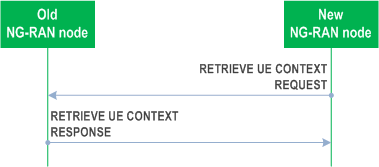
The new NG-RAN node initiates the procedure by sending the RETRIEVE UE CONTEXT REQUEST message to the old NG-RAN node.
If the old NG-RAN node is able to identify the UE context by means of the UE Context ID, and to successfully verify the UE by means of the integrity protection contained in the RETRIEVE UE CONTEXT REQUEST message, and decides to provide the UE context to the new NG-RAN node, it shall respond to the new NG-RAN node with the RETRIEVE UE CONTEXT RESPONSE message.
If the Trace Activation IE is included in the RETRIEVE UE CONTEXT RESPONSE message, the new NG-RAN node shall, if supported, initiate the requested trace function as specified in TS 32.422.
If the Index to RAT/Frequency Selection Priority IE is contained in the RETRIEVE UE CONTEXT RESPONSE message, the new NG-RAN node shall store this information and use it as defined in TS 23.501.
If the Location Reporting Information IE is included in the RETRIEVE UE CONTEXT RESPONSE message, then the new NG-RAN node should initiate the requested location reporting functionality as defined in TS 38.413.
If the Trace Activation IE is included in the RETRIEVE UE CONTEXT RESPONSE message which includes
If the UE Context Reference at the S-NG-RAN IE is contained in the RETRIEVE UE CONTEXT RESPONSE message, the new NG-RAN node may use it to establish dual connectivity with the S-NG-RAN node and shall trigger the Retrieve UE Context Confirm procedure to the old NG-RAN node when the UE successfully resumes on the new NG-RAN node.
- the MDT Activation IE set to "Immediate MDT and Trace", then the new NG-RAN node shall if supported, initiate the requested trace session and MDT session as described in TS 32.422.
- the MDT Activation IE set to "Immediate MDT Only" or "Logged MDT only", the new NG-RAN node shall, if supported, initiate the requested MDT session as described in TS 32.422 and the target NG-RAN node shall ignore the Interfaces To Trace IE, and the Trace Depth IE.
- the MDT Location Information IE, within the MDT Configuration IE, the new NG-RAN node shall, if supported, store this information and take it into account in the requested MDT session.
- the MDT Activation IE set to "Immediate MDT Only" or "Logged MDT only", and if the Signalling based MDT PLMN List IE is included in the MDT Configuration IE, the new NG-RAN node may use it to propagate the MDT Configuration as described in TS 37.320.
- the Bluetooth Measurement Configuration IE, within the MDT Configuration IE, the new NG-RAN node shall, if supported, take it into account for MDT Configuration as described in TS 37.320.
- the WLAN Measurement Configuration IE, within the MDT Configuration IE, the new NG-RAN node shall, if supported, take it into account for MDT Configuration as described in TS 37.320.
- the Sensor Measurement Configuration IE, within the MDT Configuration IE, take it into account for MDT Configuration as described in TS 37.320.
- the MDT Configuration and if the new NG-RAN node is a gNB receiving a MDT Configuration-EUTRA IE, or the target NG-RAN node is a ng-eNB receiving a MDT Configuration-NR IE, the new NG-RAN node shall store it as part of the UE context, and use it as described in TS 37.320.
- If the NR V2X Services Authorized IE is included in the RETRIEVE UE CONTEXT RESPONSE message and it contains one or more IEs set to "authorized", the new NG-RAN node shall, if supported, consider that the UE is authorized for the relevant service(s).
- If the LTE V2X Services Authorized IE is included in the RETRIEVE UE CONTEXT RESPONSE message and it contains one or more IEs set to "authorized", the new NG-RAN node shall, if supported, consider that the UE is authorized for the relevant service(s).
- If the NR UE Sidelink Aggregate Maximum Bit Rate IE is included in the UE Context Information Retrieve UE Context Response IE in the RETRIEVE UE CONTEXT RESPONSE message, the new NG-RAN node shall, if supported, use the received value for the concerned UE's sidelink communication in network scheduled mode for NR V2X services.
- If the LTE UE Sidelink Aggregate Maximum Bit Rate IE is included in the UE Context Information Retrieve UE Context Response IE in the RETRIEVE UE CONTEXT RESPONSE message, the new NG-RAN node shall, if supported, use the received value for the concerned UE's sidelink communication in network scheduled mode for LTE V2X services.
- If the 5G ProSe Authorized IE is included in the RETRIEVE UE CONTEXT RESPONSE message and it contains one or more IEs set to "authorized", the new NG-RAN node shall, if supported, consider that the UE is authorized for the relevant service(s).
- If the 5G ProSe UE PC5 Aggregate Maximum Bit Rate IE is included in the UE Context Information - Retrieve UE Context Response IE in the RETRIEVE UE CONTEXT RESPONSE message, the new NG-RAN node shall, if supported, use the received value for the concerned UE's sidelink communication in network scheduled mode for 5G ProSe services.
- If the 5G ProSe PC5 QoS Parameters IE is included in the RETRIEVE UE CONTEXT RESPONSE message, the new NG-RAN node shall, if supported, use it as defined in TS 23.304.
- If the No PDU Session Indication IE is contained in the UE Context Information - Retrieve UE Context Response IE of the RETRIEVE UE CONTEXT RESPONSE message, the new NG-RAN node shall, if supported, consider the UE as an IAB-node which does not have any PDU sessions activated, and ignore the PDU Session Resources To Be Setup List IE in the UE Context Information - Retrieve UE Context Response IE, and shall not take any action with respect to PDU session setup.
8.2.4.3 Unsuccessful Operation p. 35
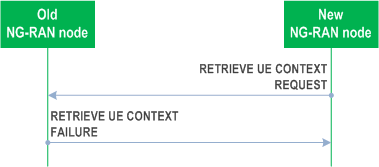
If the old NG-RAN node is not able to identify the UE context by means of the UE Context ID, or if the integrity protection contained in the RETRIEVE UE CONTEXT REQUEST message is not valid, or, if it decides not to provide the UE context to the new NG-RAN node, it shall respond to the new NG-RAN node with the RETRIEVE UE CONTEXT FAILURE message.
If the old NG-RAN node decides to keep the UE context in case of periodic RNAU or in case of RACH based SDT, it shall store the Allocated C-RNTI IE and the Access PCI IE in the UE Context ID IE, as described in TS 38.300.
If the Old NG-RAN node to New NG-RAN node Resume Container IE is included in the RETRIEVE UE CONTEXT FAILURE message, the new NG-RAN node should transparently forward the content of this IE to the UE as described in TS 38.300.
Interaction with Partial UE Context Transfer procedure
In case of RACH based SDT, if the old NG-RAN node decides to not transfer/relocate the UE Context to the new NG-RAN node, it may trigger the Partial UE Context Transfer procedure as specified in TS 38.300. After the old NG-RAN node has decided to end the SDT session, it shall terminate the Retrieve UE Context procedure by sending the RETRIEVE UE CONTEXT FAILURE message.
8.2.4.4 Abnormal Conditions p. 35
Void.
8.2.5 RAN Paging p. 35
8.2.5.1 General p. 35
The purpose of the RAN Paging procedure is to enable the NG-RAN node1 to request paging of a UE in the NG-RAN node2.
The procedure uses non UE-associated signalling.
8.2.5.2 Successful operation p. 36

The RAN Paging procedure is triggered by the NG-RAN node1 by sending the RAN PAGING message to the NG-RAN node2, in which the necessary information e.g. UE RAN Paging Identity should be provided.
If the Paging Priority IE is included in the RAN PAGING message, the NG-RAN node2 may use it to prioritize paging.
If the Assistance Data for RAN Paging IE is included in the RAN PAGING message, the NG-RAN node2 may use it according to TS 38.300.
If the UE Radio Capability for Paging IE is included in the RAN PAGING message, the NG-RAN node2 may use it to apply specific paging schemes.
If the Extended UE Identity Index Value IE is included in the RAN PAGING message, the NG-RAN node2 may use it according to TS 36.304. When available, NG-RAN node1 may include the Extended UE Identity Index Value IE in the RAN PAGING message towards an ng-eNB (e.g. NG-RAN node2).
When available, the NG-RAN node1 shall include the E-UTRA Paging eDRX Information IE in the RAN PAGING message towards the NG-RAN node2. If the E-UTRA Paging eDRX Information IE is included in the RAN PAGING message, the NG-RAN node2 shall, if supported, use it according to TS 36.304.
When available, the NG-RAN node1 shall include the UE Specific DRX IE in the RAN PAGING message towards the NG-RAN node2. If the UE specific DRX IE is included in the RAN PAGING message, the NG-RAN node2 shall, if supported, use it according to TS 36.304.
When available, the NG-RAN node1 shall include the NR Paging eDRX Information IE in the RAN PAGING message towards the NG-RAN node2. If the NR Paging eDRX Information IE is included in the RAN PAGING message, the NG-RAN node2 shall, if supported, use it according to TS 38.304.
If the NR Paging eDRX Information for RRC INACTIVE IE is included in the RAN PAGING message, the NG-RAN node2 shall, if supported, use it according to TS 38.304.
When available, the NG-RAN node1 shall include the Paging Cause IE in the RAN PAGING message towards the NG-RAN node2. If the Paging Cause IE is included in the RAN PAGING message, the NG-RAN node2 shall, if supported, use it according to TS 38.331.
If the PEIPS Assistance Information IE is included in the RAN PAGING message, the NG-RAN node2 shall, if supported, use it according to TS 38.300.
8.2.5.3 Unsuccessful Operation p. 36
Not applicable.
8.2.5.4 Abnormal Condition p. 36
Void.
8.2.6 XN-U Address Indication p. 37
8.2.6.1 General p. 37
For the retrieval of a UE context, the Xn-U Address Indication procedure is used to provide forwarding addresses from the new NG-RAN node to the old NG-RAN node for all PDU session resources successfully established at the new NG-RAN node for which forwarding was requested.
For MR-DC with 5GC, the Xn-U Address Indication procedure is used to provide data forwarding related information, and Xn-U bearer address information for completion of setup of SN terminated bearers from the M-NG-RAN node to the S-NG-RAN node as specified in TS 37.340,
The procedure uses UE-associated signalling.
8.2.6.2 Successful Operation p. 37


UE Context Retrieval
The Xn-U Address Indication procedure is initiated by the new NG-RAN node. Sending the XN-U ADDRESS INDICATION message, the new NG-RAN node informs the old NG-RAN node of successfully established PDU Session Resource contexts to which user data pending at the old NG-RAN node can be forwarded.
The new NG-RAN node may include Secondary Data Forwarding Info from target NG-RAN node List IE for an additional Xn-U tunnel for data forwarding.
Upon reception of the XN-U ADDRESS INDICATION message, the old NG-RAN node should forward pending user data to the indicated TNL addresses.
MR-DC with 5GC
The Xn-U Address Indication procedure is initiated by the M-NG-RAN node.
Upon reception of the XN-U ADDRESS INDICATION message, in case of data forwarding, the S-NG-RAN node should forward pending DL user data to the indicated TNL addresses; in case Data Forwarding Info from target E-UTRAN node IE is received, the S-NG-RAN node should perform inter-system direct data forwarding to the indicated TNL addresses as specified in TS 38.300; in case of completion of Xn-U bearer establishment for SN terminated bearers, the S-NG-RAN node may start delivery of user data to the indicated TNL address, and shall, if supported, use the received QoS Mapping Information IE within the DRBs to Be Setup List IE in the PDU Session Resource Setup Complete Info - SN terminated IE to set DSCP and/or IPv6 flow label fields for the delivery of user data to the indicated TNL address.
If the XN-U ADDRESS INDICATION message includes the DRB IDs taken into use IE, the S-NG-RAN node shall, if applicable, act as specified in TS 37.340.
If the XN-U ADDRESS INDICATION message includes the CHO MR-DC Indicator IE, the S-NG-RAN node shall, if supported, consider that the XN-U ADDRESS INDICATION message concerns a Conditional Handover, and act as specified in TS 37.340. If the CHO MR-DC Indicator IE is set to "coordination-only", the S-NG-RAN node shall, if supported, act as specified in TS 37.340.
If the XN-U ADDRESS INDICATION message includes the CHO MR-DC Early Data Forwarding Indicator IE set to "stop", the S-NG-RAN node shall, if supported and if already initiated, stop early data forwarding for the provided Data Forwarding Address information.
If the XN-U ADDRESS INDICATION message includes the CPC Data Forwarding indicator IE set to "triggered", the S-NG-RAN node shall, if supported, consider that the XN-U ADDRESS INDICATION message concerns a Conditional PSCell Change, and act as specified in TS 37.340. If the CPC Data Forwarding Indicator IE is present and value set to "early data transmission stop", the S-NG-RAN node shall, if supported and if already initiated, stop early data forwarding for the provided Data Forwarding Address information. If the CPC Data Forwarding indicator IE is set to "coordination-only", the S-NG-RAN node shall, if supported, act as specified in TS 37.340.
8.2.6.3 Unsuccessful Operation p. 38
Not applicable.
8.2.6.4 Abnormal Conditions p. 38
Void.
8.2.7 UE Context Release p. 38
8.2.7.1 General p. 38
For handover, the UE Context Release procedure is initiated by the target NG-RAN node to indicate to the source NG-RAN node that radio and control plane resources for the associated UE context are allowed to be released.
For dual connectivity, the UE Context Release procedure is initiated by the M-NG-RAN node to initiate the release the UE context at the S-NG-RAN node. For dual connectivity specific mobility scenarios specified in TS 37.340, where SCG radio resources in the S-NG-RAN node are kept, only resources related to the UE-associated signalling connection between the M-NG-RAN node and the S-NG-RAN node are released.
For UE context retrieval, the UE Context Release procedure is initiated by the new NG-RAN node to indicate to the old NG-RAN node that radio and control plane resources for the associated UE context are allowed to be released.
The procedure uses UE-associated signalling.
8.2.7.2 Successful Operation p. 39



Handover
The UE Context Release procedure is initiated by the target NG-RAN node. By sending the UE CONTEXT RELEASE message the target NG-RAN node informs the source NG-RAN node of Handover success and triggers the release of resources.
Upon reception of the UE CONTEXT RELEASE message, the source NG-RAN node may release radio and control plane related resources associated to the UE context. If data forwarding has been performed, the source NG-RAN node should continue forwarding of user plane data as long as packets are received at the source NG-RAN node.
Dual Connectivity
The UE Context Release procedure is initiated by the M-NG-RAN node. By sending the UE CONTEXT RELEASE message the M-NG-RAN node informs the S-NG-RAN node that the UE Context can be removed.
Upon reception of the UE CONTEXT RELEASE message, the S-NG-RAN node may release radio and control plane related resources associated to the UE context. If data forwarding has been performed, the S-NG-RAN node should continue forwarding of user plane data as long as packets are received at the S-NG-RAN node.
UE Context Retrieval
The UE Context Release procedure is initiated by the new NG-RAN node. By sending the UE CONTEXT RELEASE message the new NG-RAN node informs the old NG-RAN node of RRC connection reestablishment success or RRC connection resumption success and triggers the release of resources.
Interaction with the M-NG-RAN node initiated S-NG-RAN node Release procedure:
The S-NG-RAN node may receive the S-NODE RELEASE REQUEST message including the UE Context Kept Indicator IE set to "True", upon which the S-NG-RAN node shall, if supported, only release the resources related to the UE-associated signalling connection between the M-NG-RAN node and the S-NG-RAN node, as specified in TS 37.340.
8.2.7.3 Unsuccessful Operation p. 40
Not applicable.
8.2.7.4 Abnormal Conditions p. 40
If the UE Context Release procedure is not initiated towards the source NG-RAN node from any prepared NG-RAN node before the expiry of the timer TXnRELOCoverall, the source NG-RAN node shall request the AMF to release the UE context.
If the UE returns to source NG-RAN node before the reception of the UE CONTEXT RELEASE message or the expiry of the timer TXnRELOCoverall, the source NG-RAN node shall stop the TXnRELOCoverall and continue to serve the UE.
8.2.8 Handover Success |R16| p. 40
8.2.8.1 General p. 40
The Handover Success procedure is used during a conditional handover or a DAPS handover to enable a target NG-RAN node to inform the source NG-RAN node that the UE has successfully accessed the target NG-RAN node.
The procedure uses UE-associated signalling.
8.2.8.2 Successful Operation p. 40

The target NG-RAN node initiates the procedure by sending the HANDOVER SUCCESS message to the source NG-RAN node.
If late data forwarding was configured for this UE, the source NG-RAN node shall start data forwarding using the tunnel information related to the global target cell ID provided in the HANDOVER SUCCESS message.
When the source NG-RAN node receives the HANDOVER SUCCESS message, it shall consider all other CHO preparations accepted for this UE under the same UE-associated signalling connection in the target NG-RAN node as cancelled.
Interactions with other procedures
If a CONDITIONAL HANDOVER CANCEL message was received for this UE prior the reception of the HANDOVER SUCCESS message, the source NG-RAN node shall consider that the UE successfully executed the handover.
The source NG-RAN node may initiate Handover Cancel procedure towards the other signalling connections or other candidate target NG-RAN nodes for this UE, if any.
8.2.8.3 Unsuccessful Operation p. 41
Not applicable.
8.2.8.4 Abnormal Conditions p. 41
If the HANDOVER SUCCESS message refers to a context that does not exist, the source NG-RAN node shall ignore the message.
8.2.9 Conditional Handover Cancel |R16| p. 41
8.2.9.1 General p. 41
The Conditional Handover Cancel procedure is used to enable a target NG-RAN node to cancel an already prepared conditional handover.
The procedure uses UE-associated signalling.
8.2.9.2 Successful Operation p. 41

The target NG-RAN node initiates the procedure by sending the CONDITIONAL HANDOVER CANCEL message to the source NG-RAN node. The target NG-RAN node shall indicate the reason for cancelling the conditional handover by means of an appropriate cause value.
At the reception of the CONDITIONAL HANDOVER CANCEL message, the source NG-RAN node shall consider that the target NG-RAN node is about to remove any reference to, and release any resources previously reserved for candidate cells associated to the UE-associated signalling identified by the Source NG-RAN node UE XnAP ID IE and the Target NG-RAN node UE XnAP ID IE. If the Candidate Cells To Be Cancelled List IE is included in CONDITIONAL HANDOVER CANCEL message, the source NG-RAN node shall consider that only the resources reserved for the cells identified by the included NG-RAN CGI are about to be released.
8.2.9.3 Unsuccessful Operation p. 41
Not applicable.
8.2.9.4 Abnormal Conditions p. 42
If the CONDITIONAL HANDOVER CANCEL message refers to a context that does not exist, the source NG-RAN node shall ignore the message.
If one or more candidate cells in the Candidate Cells To Be Cancelled List IE included in the CONDITIONAL HANDOVER CANCEL message were not prepared using the same UE-associated signaling connection, the source NG-RAN node shall ignore those non-associated candidate cells.
8.2.10 Early Status Transfer |R16| p. 42
8.2.10.1 General p. 42
The purpose of the Early Status Transfer procedure is to transfer the COUNT of the first downlink SDU that the source NG-RAN node forwards to the target NG-RAN node or the COUNT for discarding of already forwarded downlink SDUs for respective DRB during DAPS Handover or Conditional Handover.
For MR-DC with 5GC, the Early Status Transfer procedure is also used from the source S-NG-RAN node to the source M-NG-RAN node during a Conditional Handover as specified in TS 37.340.
The procedure uses UE-associated signalling.
For Conditional PSCell Addition in MR-DC with NR SCG, the Early Status Transfer procedure is also used, from the M-NG-RAN node to the S-NG-RAN node as specified in TS 37.340.
For Conditional PSCell Change in MR-DC with NR SCG, the Early Status Transfer procedure is also used from the source S-NG-RAN node to the M-NG-RAN node, and from the M-NG-RAN node to the target S-NG-RAN node as specified in TS 37.340.
8.2.10.2 Successful Operation p. 42

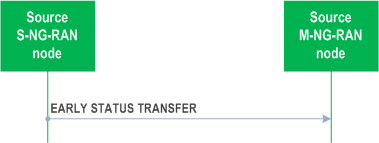
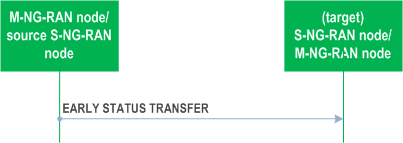
From source NG-RAN node to target NG-RAN node
The DRBs Subject To Early Status Transfer List IE included in the EARLY STATUS TRANSFER message contains the DRB ID(s) corresponding to the DRB(s) subject to be simultaneously served by the source and the target NG-RAN nodes during DAPS Handover or the DRB(s) transferred during Conditional Handover.
For each DRB in the DRBs Subject To Early Status Transfer List IE, the target NG-RAN node shall use the value of the FIRST DL COUNT Value IE as the COUNT of the first downlink SDU that the source NG-RAN node forwards to the target NG-RAN node.
For each DRB in the DRBs Subject To Early Status Transfer List IE for which the DISCARD DL COUNT Value IE is received in the EARLY STATUS TRANSFER message, the target NG-RAN node does not transmit forwarded downlink SDUs to the UE whose COUNT is less than the provided and discards them if transmission has not been attempted.
From source S-NG-RAN node to source M-NG-RAN node, the source NG-RAN node for Conditional Handover
The DRBs Subject To Early Status Transfer List IE included in the EARLY STATUS TRANSFER message contains the DRB ID(s) corresponding to the DRB(s) transferred during Conditional Handover.
For each DRB in the DRBs Subject To Early Status Transfer List IE, the source M-NG-RAN node shall forward to the target, the value of the received FIRST DL COUNT Value IE or DISCARD DL COUNT Value IE.
From M-NG-RAN node to S-NG-RAN node, for Conditional PSCell Addition
The DRBs Subject To Early Status Transfer List IE included in the EARLY STATUS TRANSFER message contains the DRB ID(s) corresponding to the DRB(s) transferred during Conditional PSCell Addition.
For each DRB in the DRBs Subject To Early Status Transfer List IE, the M-NG-RAN node shall forward to the S-NG-RAN node, the value of the received FIRST DL COUNT Value IE or DISCARD DL COUNT Value IE.
From source S-NG-RAN node to M-NG-RAN node, and from M-NG-RAN node to target S-NG-RAN node, for Conditional PSCell Change
The DRBs Subject To Early Status Transfer List IE included in the EARLY STATUS TRANSFER message contains the DRB ID(s) corresponding to the DRB(s) transferred during Conditional PSCell Change.
For each DRB in the DRBs Subject To Early Status Transfer List IE, the source S-NG-RAN node shall forward to the M-NG-RAN node and the M-NG-RAN node shall forward to the target S-NG-RAN node, during Conditional PSCell Change, the value of the received FIRST DL COUNT Value IE or DISCARD DL COUNT Value IE.
8.2.10.3 Unsuccessful Operation p. 43
Not applicable.
8.2.10.4 Abnormal Conditions p. 43
If the target NG-RAN node receives this message for a UE for which no prepared DAPS Handover or Conditional Handover exists at the target NG-RAN node, the target NG-RAN node shall ignore the message.
8.2.11 RAN Multicast Group Paging |R17| p. 44
8.2.11.1 General p. 44
The purpose of the RAN Multicast Group Paging procedure is to enable the NG-RAN node1 to request paging of UEs that have joined an MBS Session in the NG-RAN node2.
The procedure uses non UE-associated signalling.
8.2.11.2 Successful operation p. 44

The RAN Multicast Group Paging procedure is triggered by the NG-RAN node1 by sending the RAN MULTICAST GROUP PAGING message to the NG-RAN node2.
If the RAN MULTICAST GROUP PAGING message includes the Paging DRX IE, the NG-RAN node2.shall, if supported, use it according to TS 38.304.
8.2.12 Retrieve UE Context Confirm |R17| p. 44
8.2.12.1 General p. 44
The Retrieve UE Context Confirm procedure is used by the new NG-RAN node to inform the old NG-RAN node whether the S-NG-RAN node associated with the old NG-RAN node for the UE that was indicated during UE context retrieval is kept or not by the new NG-RAN node during RRC resumption.
In case of RACH based SDT without UE context relocation, the Retrieve UE Context Confirm procedure is also used to request the termination of SDT session from the new NG-RAN node to the old NG-RAN node.
The procedure uses UE-associated signalling.
8.2.12.2 Successful Operation p. 44

The new NG-RAN node initiates the procedure by sending the RETRIEVE UE CONTEXT CONFIRM message to the old NG-RAN node.
Upon reception of the RETRIEVE UE CONTEXT CONFIRM message, the old NG-RAN node shall release the resources related to the UE-associated signalling connection between the old NG-RAN node and the new NG-RAN node, as specified in TS 37.340.
If the UE Context Kept Indicator IE is included and set to "True", the old NG-RAN node shall consider that the S-NG-RAN node was kept by the new NG-RAN node and use this information as specified in TS 37.340.
If the old NG-RAN node receives the SDT Termination Request IE in the RETRIEVE UE CONTEXT CONFIRM message, the old NG-RAN node shall, if supported, consider that the termination of the ongoing SDT session is requested from the new NG-RAN node for this UE and act as specified in TS 38.300.
8.2.12.3 Unsuccessful Operation p. 45
Not applicable.
8.2.12.4 Abnormal Conditions p. 45
If the RETRIEVE UE CONTEXT CONFIRM message refers to a context that does not exist, the old NG-RAN node shall ignore the message.
8.2.13 Partial UE Context Transfer |R17| p. 45
8.2.13.1 General p. 45
The purpose of the Partial UE Context Transfer procedure is to partially transfer the UE context from the old NG-RAN node to the new NG-RAN node.
The procedure uses UE-associated signalling.
8.2.13.2 Successful Operation p. 45
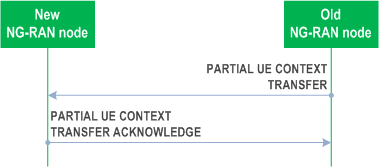
The old NG-RAN node initiates the procedure by sending the PARTIAL UE CONTEXT TRANSFER message to the new NG-RAN node.
If the new NG-RAN node is able to accept the SDT session without anchor relocation, it shall, if supported, respond to the old NG-RAN node with the PARTIAL UE CONTEXT TRANSFER ACKNOWLEDGE message.
If the Partial UE Context Information for SDT IE is included in the PARTIAL UE CONTEXT TRANSFER message, the new NG-RAN node may include data forwarding related information in the SDT Data Forwarding DRB List IE in the PARTIAL UE CONTEXT TRANSFER ACKNOWLEDGE message.
8.2.13.3 Unsuccessful Operation p. 46
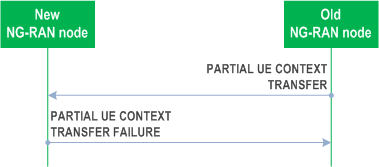
If the new NG-RAN is not able to accept the SDT session without anchor relocation, it shall respond to the old NG-RAN node with the PARTIAL UE CONTEXT TRANSFER FAILURE message.
8.2.13.4 Abnormal Condition p. 46
Void.